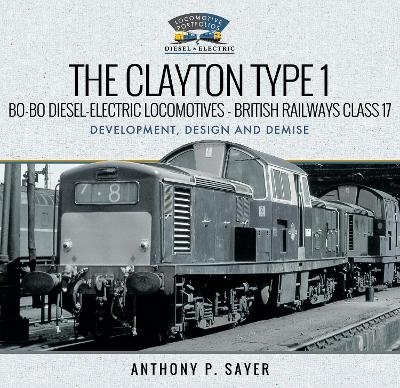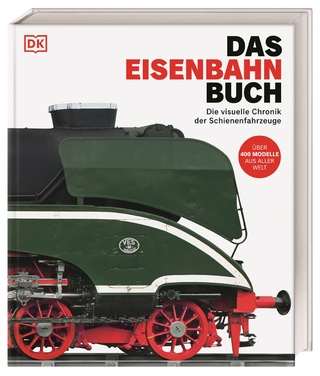
The Clayton Type 1 Bo-Bo Diesel-Electric Locomotives - British Railways Class 17
Development, Design and Demise
Seiten
2021
Pen & Sword Transport (Verlag)
978-1-5267-6200-9 (ISBN)
Pen & Sword Transport (Verlag)
978-1-5267-6200-9 (ISBN)
Newly researched information with good photographic coverage.
The 'Claytons' were originally conceived as the British Railways "standard" Type 1 diesel-electric locomotive, superseding other Type 1 classes delivered as part of the 'Pilot Scheme' fleet. The early classes suffered from poor driver visibility, and the plan from 1962 was for subsequent trip-freight and local yard shunting locomotives to be centre-cab machines with low bonnets to dramatically improve visibility.
To this extent the Claytons were highly successful and popular with operating crews. However, the largely untested high-speed, flat Paxman engines proved to be highly problematical, resulting in deliveries being curtailed after 117 locomotives. Further requirements for Type 1 locomotives after 1965 were met by reverting to one of the original 'Pilot' designs! Deteriorating traffic levels ultimately led to the Claytons being withdrawn from BR service by December 1971.
Considerable amounts of archive material have been unearthed to enable the issues surrounding the rise and fall of the 'Standard Type 1' locomotives to be fully explored. Further sources provide insights into the effort and money expended on the Claytons in a desperate attempt to improve their reliability. Individual locomotive record cards, together with personal sighting information, allow histories of each class member to be developed including allocations, works visits, liveries and disposal details.
Supported by over 280 photographs and diagrams, dramatic new insights into this troubled class have been assembled for both historians and modellers alike.
The 'Claytons' were originally conceived as the British Railways "standard" Type 1 diesel-electric locomotive, superseding other Type 1 classes delivered as part of the 'Pilot Scheme' fleet. The early classes suffered from poor driver visibility, and the plan from 1962 was for subsequent trip-freight and local yard shunting locomotives to be centre-cab machines with low bonnets to dramatically improve visibility.
To this extent the Claytons were highly successful and popular with operating crews. However, the largely untested high-speed, flat Paxman engines proved to be highly problematical, resulting in deliveries being curtailed after 117 locomotives. Further requirements for Type 1 locomotives after 1965 were met by reverting to one of the original 'Pilot' designs! Deteriorating traffic levels ultimately led to the Claytons being withdrawn from BR service by December 1971.
Considerable amounts of archive material have been unearthed to enable the issues surrounding the rise and fall of the 'Standard Type 1' locomotives to be fully explored. Further sources provide insights into the effort and money expended on the Claytons in a desperate attempt to improve their reliability. Individual locomotive record cards, together with personal sighting information, allow histories of each class member to be developed including allocations, works visits, liveries and disposal details.
Supported by over 280 photographs and diagrams, dramatic new insights into this troubled class have been assembled for both historians and modellers alike.
ANTHONY SAYER is a life-long railway enthusiast with an interest in the history of the early British diesel and electric locomotive classes. This is the third of several books in the Locomotive Portfolio (Diesel & Electric) series, following on from the North British Type 2 Bo-Bo diesel-electric (Classes 21 & 29) and Metropolitan-Vickers Type 2 Co-Bo diesel-electric (Class 28) books published in 2019 and 2020 respectively. Anthony lives in the north-east of England and has now retired after 37 years in the steel industry with responsibilities in both transport and supply-chain planning.
| Erscheinungsdatum | 03.06.2021 |
|---|---|
| Reihe/Serie | Locomotive Portfolio Diesel and Electric |
| Zusatzinfo | 200 colour & black and white illustrations, weight diagrams & a class list |
| Verlagsort | Barnsley |
| Sprache | englisch |
| Maße | 250 x 240 mm |
| Themenwelt | Natur / Technik ► Fahrzeuge / Flugzeuge / Schiffe ► Schienenfahrzeuge |
| ISBN-10 | 1-5267-6200-5 / 1526762005 |
| ISBN-13 | 978-1-5267-6200-9 / 9781526762009 |
| Zustand | Neuware |
| Informationen gemäß Produktsicherheitsverordnung (GPSR) | |
| Haben Sie eine Frage zum Produkt? |
Mehr entdecken
aus dem Bereich
aus dem Bereich
Das Beste aus Stadt und Land.
Buch | Softcover (2024)
VUD Medien (Verlag)
12,00 €
Buch | Softcover (2024)
hidden europe publications (Verlag)
26,15 €
die visuelle Chronik der Schienenfahrzeuge
Buch | Hardcover (2024)
DK Verlag Dorling Kindersley
34,95 €


